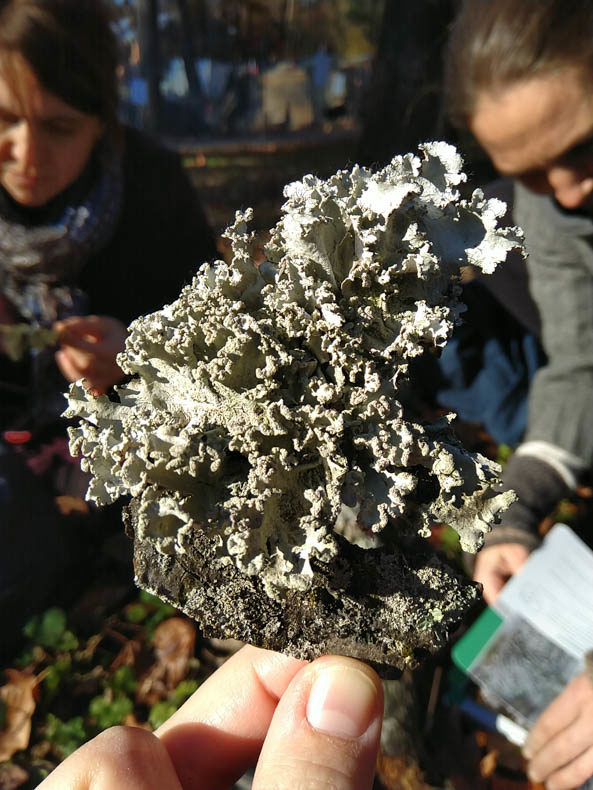
On the Sunday after Thanksgiving, a beautiful sunny afternoon, I met a friend and her sister in a park along a creek for a lichen walk.
I had a small obsession with lichens a few years ago, and I wrote about it in a three-part series for this blog. (Part one, part two, part three.) Lichens are a symbiosis: A fungus provides shelter and structure, and cyanobacteria or algae live in its tissues, making energy from sunlight to keep the whole thing going. And, scientists have learned since I last wrote about lichen, many species contain a third partner, a strain of yeast.
I brought my lighted hand lens and guide book, holdovers from my lichen moment of 2016; they brought observational skills and tree knowledge. We started with a tree close to a picnic table, handy for coats and bags.
I started with what I remembered – that a lot of lichens that look the same at first glance are actually different species. Several were sage green, but one had long black eyelash-like cilia sticking out from its edges. Others had tiny black spots, or skinnier lobes, or a different shade of green. On the sunny side of the tree, a crust-like yellowish species was growing.
With a lot of discussion and passing around of the hand lens and reading aloud from the book, we got to one possible identification: The most common one on that tree might have been Punctelia rudecta, which the author of my guidebook has named rough speckled shield lichen.
A woman stopped by with her pretty poodle to ask what we were doing. She knew what lichen were—it turned out she had a biology background—and she said it was so important to stop and look at things.
At one point the sisters got into a discussion about what kind of tree it was. I have a fighting chance with trees when there are leaves, but it was winter, and it had no leaves, so my money was on “deciduous.” They agreed that something about the remaining dry bits high up above us made it a tulip poplar.
On the next tree, a different species caught our eyes, a round clump of bright green lichen with miniscule lobes…that moved, shuffling up a crack in the bark. Lichens do not walk and they do not shuffle. Minds were blown. I scraped one off the tree trunk and onto the book cover. I’d managed to get it onto its back and it flopped angrily, waving its legs. Eventually it curled up into an angry ball and waited for us to leave it alone.
A quick check of the internet—thanks, smartphones—introduced us to a new creature: a lacewing larva that covers itself in lichen bits and bobs and the carcasses of its meals. Which is a little grisly and extremely tough.
A thing about a lichen walk is that there isn’t much walking involved. You can find half a dozen species without leaving a tree. Later we tried to set off down the trail a bit, then got waylaid by some branches that had fallen from high in a tree and had all sorts of interesting lichens we hadn’t seen in the bottom six feet of a tree trunk.
We sat on the damp grass, passing around the hand lens, the book, and bits of licheny bark. We read descriptions out loud, trying to get the new words from the lichen book into our heads—the rhizines, the apothecia, the soredia. We came up with identifications for four more species: Parmotrema perlatum, with tons of cilia; Physica stellaris, with the prettiest, tiniest brown and black cups; Flavoparmelia caprata, or common greenshield, a lichen so distinctive that the book says you can identify it from a moving vehicle, which I believe; and Candelaria concolor, maybe.
A few hours with lichen had so many pleasures. The friendly dogs. Sitting on the ground in the slanting harsh winter sun, no leaves to filter it, exclaiming over cilia. And all of us losing our minds about that angry little lacewing. The poodle lady was right. It’s worth it, stopping to look.
Ooo! We love to stop and look at plants & trees, often taking a tree or flower identifier book along. Is there a specific lichen guide-book you use? Recommendations welcome
Love love love lichen! Endlessly fascinating
The lichen guidebook I’ve been using is Common Lichens of Northeastern North America by Troy McMullin & Frances Anderson.